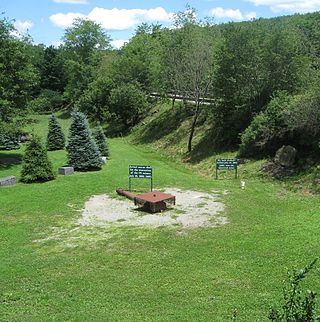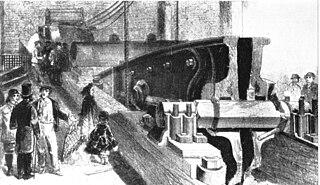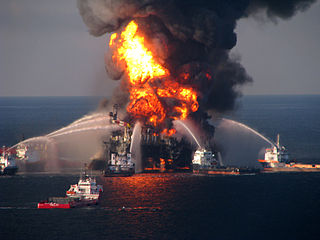Related Research Articles
A mining accident is an accident that occurs during the process of mining minerals or metals. Thousands of miners die from mining accidents each year, especially from underground coal mining, although accidents also occur in hard rock mining. Coal mining is considered much more hazardous than hard rock mining due to flat-lying rock strata, generally incompetent rock, the presence of methane gas, and coal dust. Most of the deaths these days occur in developing countries, and rural parts of developed countries where safety measures are not practiced as fully. A mining disaster is an incident where there are five or more fatalities.

The Knox Mine disaster was a mining accident on January 22, 1959, at the River Slope Mine in Jenkins Township, Pennsylvania.
New Waterford is an urban community in the Cape Breton Regional Municipality of Nova Scotia, Canada.

The Quecreek Mine rescue took place in Somerset County, Pennsylvania, when nine miners were trapped underground for over 77 hours, from July 24 to 28, 2002. All nine miners were rescued.

The Hartley Colliery disaster was a coal mining accident in Northumberland, England, that occurred on 16 January 1862 and resulted in the deaths of 204 men and children. The beam of the pit's pumping engine broke and fell down the shaft, trapping the men below. The disaster prompted a change in British law that required all collieries to have at least two independent means of escape.
IISCO Steel Plant of Steel Authority of India Limited is an integrated steel plant located at Burnpur, a neighbourhood in Asansol city, in the Asansol subdivision of Paschim Bardhaman district, West Bengal, India.

Mining in Australia has long been a significant primary sector industry and contributor to the Australian economy by providing export income, royalty payments and employment. Historically, mining booms have also encouraged population growth via immigration to Australia, particularly the gold rushes of the 1850s. Many different ores, gems and minerals have been mined in the past and a wide variety are still mined throughout the country.

The Lofthouse Colliery disaster was a mining accident in the West Riding of Yorkshire, England, on Wednesday 21 March 1973, in which seven mine workers died when workings flooded.
The 2007 Shandong coal mine flood was an incident that occurred on August 17, 2007 in Xintai, Shandong, People's Republic of China, when heavy rain caused a river to burst a levee creating a flood into two mine shafts. By 8:50 am (1:50GMT), the mine was inundated underwater.

Mining in New Zealand began when the Māori quarried rock such as argillite in times prior to European colonisation. Mining by Europeans began in the latter half of the 19th century.

Energy resources bring with them great social and economic promise, providing financial growth for communities and energy services for local economies. However, the infrastructure which delivers energy services can break down in an energy accident, sometimes causing considerable damage. Energy fatalities can occur, and with many systems deaths will happen often, even when the systems are working as intended.

On 13 May 2014, blasting at Eynez coal mine in Soma, Manisa, Turkey, caused an underground mine fire, which burned until 15 May. In total, 301 people were killed in what was the worst mine disaster in Turkey's history. The mine, operated by coal producer Soma Kömür İşletmeleri A.Ş., suffered a fire, the causes of which were later found to be complex. The fire occurred at the mine's shift change, and 787 workers were underground at the time. At the time the disaster was thought to be mainly an explosion rather than fire. After the final bodies were pulled from the mine on 17 May 2014, four days after the fire, the Minister of Energy and Natural Resources Taner Yıldız confirmed the number of dead was 301. Disaster and Emergency Management Presidency (AFAD) announced the names of 301 workers who died in the mine disaster and 486 people who survived.

In February 2016, a series of explosions caused the deaths of 36 people, including 31 miners and five rescue workers, at the Severnaya coal mine 10 kilometres north of the city of Vorkuta, Komi Republic, Russia. The explosions were believed to be caused by ignition of leaking methane gas. It is the second deadliest mining disaster of the 2010s behind the Soma mine disaster, and fourth deadliest of the 21st century thus far.

The Lundhill Colliery explosion was a coal mining accident which took place on 19 February 1857 in Wombwell, Yorkshire, UK in which 189 men and boys aged between 10 and 59 died. It is one of the biggest industrial disasters in the country's history and it was caused by a firedamp explosion. It was the first disaster to appear on the front page of the Illustrated London News.
Sodepur Area is one of the 14 operational areas of Eastern Coalfields Limited located mainly in Asansol subdivision of Paschim Bardhaman district and partly of Raghunathpur subdivision in Purulia district, both in the state of West Bengal, India.

The Meghalaya mining accident happened on 13 December 2018, when 15 miners were trapped in a mine in Ksan, in the Indian state of Meghalaya. While five miners managed to escape, rescue efforts for the remaining 10 continued till 2 March 2019. The miners were trapped inside the coal mine at a depth of around 370 feet in Jaintia Hills district after digging with the rat-hole mining technique. The tunnel the miners were in flooded with water after they cut into an adjacent mine which was full of water from the nearby Lytein river.
Kalyan Roy, also credited as Kalyan Shankar Roy was an Indian politician and a leader of Communist Party of India and also a leader of All India Trade Union Congress. One of the famous trade union leaders of Asansol-Raniganj coalfield area, Kalyan Roy was one of the senior CPI leader and parliamentarian in Rajya Sabha.
Rat-hole mining or Rat mining is a process of digging employed in North East India to extract coal, where a narrow hole is manually dug by extraction workers. The practice is banned by the National Green Tribunal; however, the techniques are still employed by artisanal mining operations in several parts of India, especially in Meghalaya.
References
- 1 2 3 Bobb, Dilip (15 January 1976). "Bihar Chas Nala colliery disaster: 372 coal miners buried alive". India Today. Retrieved 26 March 2021.
- 1 2 3 4 5 Ashutosh, Anil (28 December 2012). "Chasnala mine disaster victims remembered". The Times of India. Retrieved 26 March 2021.
- 1 2 3 4 Pandey, Prashant (22 January 2016). "Chasnala, 40 years later: Memories of a flooded mine recede". The Indian Express. Retrieved 20 March 2016.
- ↑ "This Day In History - Dec 27 - Coal mine explodes in India". History.com. Archived from the original on 10 March 2018.
- ↑ Dash, A. K.; Bhattacharjee, R. M.; Paul, P. S. (December 2016). "Lessons learnt from Indian inundation disasters: An analysis of case studies". International Journal of Disaster Risk Reduction. 20: 93–102. doi:10.1016/j.ijdrr.2016.10.013.
- ↑ Mishra, Law Kumar (17 March 2012). "A year in jail & fine for Chasnala accused". The Times of India. Retrieved 26 March 2021.